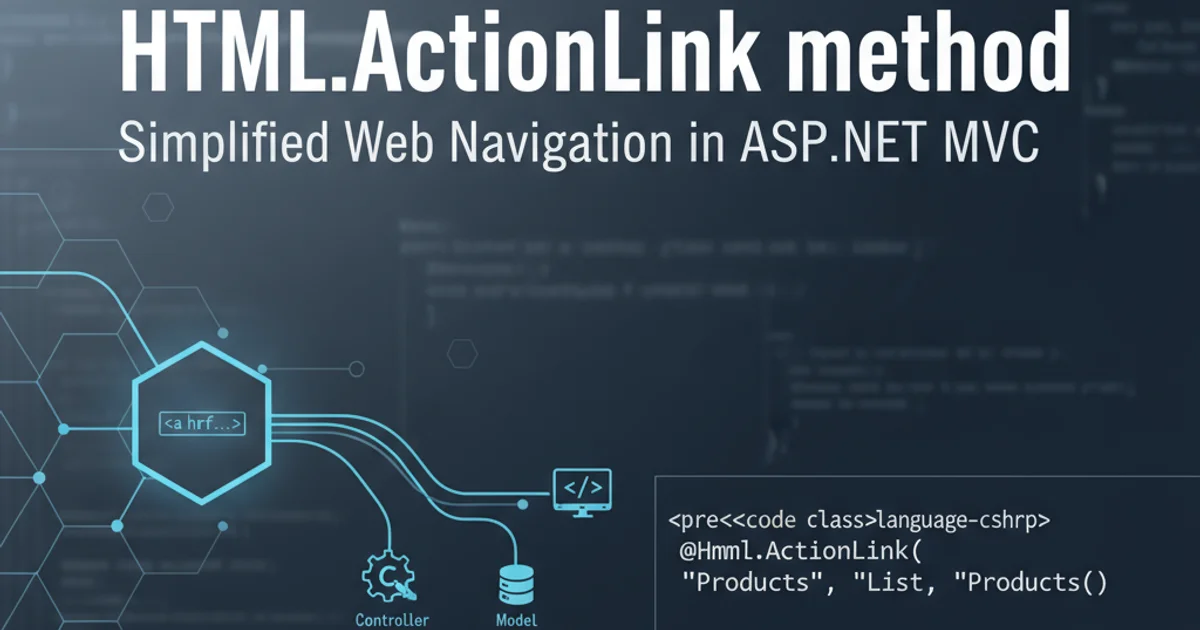HTML.ActionLink method
Categories:
Mastering HTML.ActionLink in ASP.NET MVC

Explore the versatility of the HTML.ActionLink helper method in ASP.NET MVC for generating robust and SEO-friendly hyperlinks.
The HTML.ActionLink helper method is a fundamental component in ASP.NET MVC for generating HTML <a> (anchor) tags that link to other actions within your application. Unlike hardcoding URLs, ActionLink provides several benefits, including type safety, easier refactoring, and automatic URL routing based on your defined routes. This article delves into its various overloads and best practices for effective use.
Understanding the Basics of HTML.ActionLink
At its core, HTML.ActionLink generates a hyperlink by taking the link text, the action method name, and optionally the controller name. It then uses your application's routing configuration to construct the correct URL. This abstraction means you don't have to worry about URL changes if you rename actions or controllers, as long as your routes are correctly defined.
@Html.ActionLink("Home Page", "Index", "Home")
@Html.ActionLink("About Us", "About") // Assumes current controller
Basic usage of HTML.ActionLink
ActionLink defaults to the current controller. This is useful for linking to actions within the same controller.Passing Route Values and HTML Attributes
Often, you need to pass data to the target action, such as an id for editing a record, or apply custom HTML attributes like CSS classes to the generated link. HTML.ActionLink provides overloads that accept route values and HTML attributes as anonymous objects. Route values are typically appended to the URL, while HTML attributes are rendered directly on the <a> tag.
@Html.ActionLink("Edit Product", "Edit", "Product", new { id = 123 }, null)
@Html.ActionLink("View Details", "Details", new { id = 456 }, new { @class = "btn btn-primary", target = "_blank" })
Using route values and HTML attributes
@ prefix for class in the HTML attributes. This is because class is a reserved keyword in C#, and @class allows you to use it as a property name in an anonymous object.flowchart TD
A[View Request] --> B{HTML.ActionLink Call}
B --> C{Route Table Lookup}
C --> D{URL Generation}
D --> E[Rendered HTML `<a>` Tag]
E --> F{Browser Navigation}
F --> G[Target Action Execution]Lifecycle of an HTML.ActionLink call
Advanced Scenarios: Protocols, Hosts, and Fragments
For more complex linking requirements, such as generating absolute URLs, specifying protocols (HTTP/HTTPS), or including URL fragments (hash tags), HTML.ActionLink offers overloads that accept these parameters. This is particularly useful when dealing with external redirects, email links, or single-page applications that rely on URL fragments for navigation.
// Absolute URL with protocol and host
@Html.ActionLink("Secure Home", "Index", "Home", "https", "www.example.com", null, null, null)
// Link with a URL fragment
@Html.ActionLink("Go to Section", "Index", "Home", null, null, "sectionId", null, null)
Generating absolute URLs and links with fragments
protocol and host as it can lead to hardcoded values. Prefer using relative URLs unless an absolute URL is strictly required, for instance, in email templates.